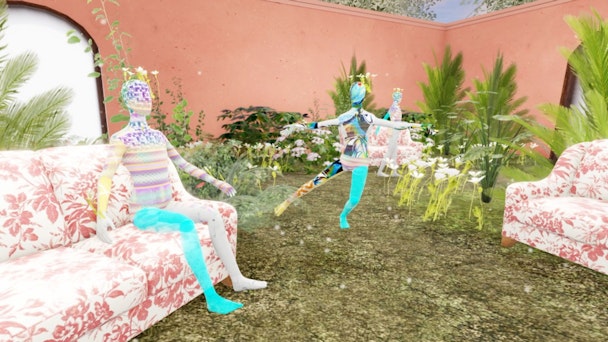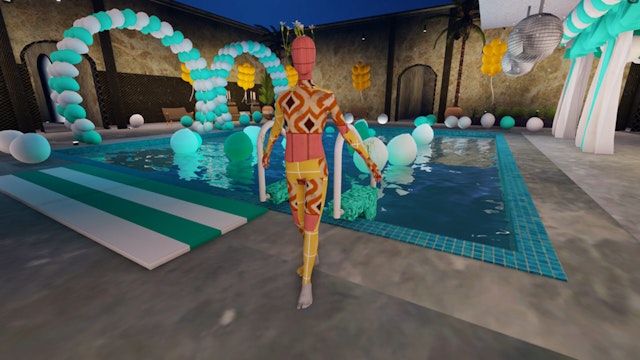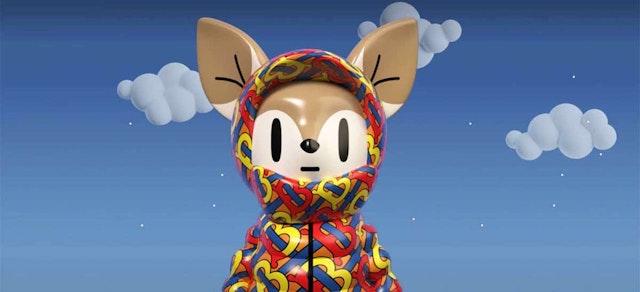
Advertisement

Gucci’s vision for its metaverse
With virtual Gucci handbag selling in Roblox game for more than real-life versions, as part of our deep dive on all things gaming we consider the opportunities fashion brands have in digital worlds where players are willing to spend serious money to create their own unique identities.
You’d think the virtual realms of Animal Crossing and League of Legends would be the last place to find the likes of Louis Vuitton, Valentino or Marc Jacobs. Yet there they are. Fashion houses traditionally catering to an elite minority are now donning their collections on millions of in-game avatars. Seemingly an odd pairing, high fashion’s migration to gaming is in fact a well-played move that will open them up to a whole new world of shoppers.
Roblox is an online gaming platform where users can immerse themselves in any of the 18 million virtual worlds created by independent developers. In the first quarter of 2021, it had 42.1 million daily active users spanning 180 countries. Contrary to popular misconceptions, 44% of its base was female.
And in Roblox’s many worlds, players can buy an array of items from an Avatar Shop using the game’s currency – a Robux. It’s in this space that Italian fashion house Gucci decided to mark its 100-year anniversary.
It created the Gucci Garden, a game made up of various themed rooms as envisioned by the brand’s creative director Alessandro Michele. As visitors wandered the rooms, they could purchase exclusive virtual Gucci items for their avatars to wear. One item proved particularly popular – the limited-edition virtual Dionysus Bag with Bee, which Gucci was selling to gamers for an original price of 475 Robux (equivalent to $6). But, just as in the real word, users can re-sell the digital wears if the demand is high. And this bag was, leading one user to sell it on for over $4,100 – $800 more than the real thing.
The hype around high fashion brands on Roblox is not restricted to Gucci, with Givenchy and Stella McCartney also recently rolling out collections for the platform.
“Users will dress their avatars up for virtual events or to show off their latest virtual fashion items, and these sorts of collaborations prove immensely popular,” says Christina Wootton, vice-president of of brand partnerships at Roblox.
“People’s individual avatars go with them wherever they go on the platform, creating an identity recognizable by friends, and we really see how much community members love to express themselves in this way. Branded experiences can feature limited-edition virtual items or collectibles to buy or earn through experiences, and within just a few days there will be millions of people sporting these new items on the platform and showing them off to their friends or wearing them to special events.”

We Are Pi, a global digital agency, conducted research that found that young people now see these virtual worlds as an important space in shaping their identity and are experimenting with different brands to find their favorites, which is inherently carried over into in the real world.
“The potential for fashion brands to make money within these emerging gaming worlds and metaverses is enormous,” says the agency’s head of strategy Mark Lester. “Fortnite has already created a multi-billion dollar industry in selling skins, and this is just the beginning.”
The idea that gamers will pay a lot of money for ‘skins’ – another word for what a digital avatar wears – was something gaming execs have been slow to take seriously. In 2019, a Scandinavian fashion company called Carlings was pitched an idea by Vice’s creative agency Virtue to create a collection of virtual skins for games. The company’s chief exec called it “the strangest meeting of my life”.
Fast forward a couple of years, and chief executive officers and chief marketing officers are finally paying attention to this burgeoning market – estimated to be worth $152bn. Louis Vuitton has launched a skins collection for Riot Games’s League of Legends, while Marc Jacobs, Valentino and Anna Sui have created exclusive collections for Animal Crossing.
“62% of UK adults played games during the pandemic. In reality, we should be long past the idea of gamers as some niche subsegment of society. Gaming has gotten so big that ‘gamers’ are pretty much everyone,” adds Lester.
“Chief marketing officers don’t always live this reality and there has been a generation gap in understanding gaming. But we are finally starting to turn a corner. Chief marketers are realizing that gamers aren’t some separate new group of people they need to target. Rather, gaming is an essential part of the leisure time of the people that already buy their products.”
Roblox’s Wootton says that some brands are now creating metaverse-focused marketing teams, much like the digital and social teams that have evolved over the last decade.

Some early adopters of gaming have realised that rules of this new marketplace will be written by the game developers. Just like Apple controls its app store and takes a massive cut of all its revenues, game developers may decide to charge fashion brands a significant fee for selling on their platforms. And so some have opted to eschew partnering with gaming platforms altogether and instead experimented with building their own virtual worlds that they own outright.
Earlier this year Burberry launched B-Bounce, an online game that can be played on the brand’s website or on a large screen installed at Burberry’s flagship store on London’s Regent Street.
The game’s protagonist – a deer – can be dressed in a variety of monogrammed outfits as it bounces around different worlds where players try to clock up as many ‘meters jumped’ as they can.
Elsewhere, Hermès decided to deliver its own take on the traditional French lawn game of horseshoe pitching. The game saw players try to win points by throwing horseshoes as close as possible to a stake in a variety of weird and wonderful environments, which culminated in a final throw in a digital version of its famed headquarters on Rue Du Faubourg Saint-Honoré.
Fabien Le Roux – head of strategic planning at BETC Etoile Rouge – says we will see more brands like Burberry and Hermes trying to bring physical and virtual worlds together.
“There will certainly be more secondary features that will become mainstream, such as livestream shopping, and that will become a part of every brand’s business and communications ecosystem, even luxury brands,” he says. “There is no secret: if people enjoy spending time in a place, brands will spend some time there as well.”
For Roblox, it is preparing for a wave of luxury brands to launch their collections on its platform. Wootton's advice for any marketer ready to jump into the world of gaming is to take time to understand the community.
“It has to be authentic and part of what the community is already experiencing on the platform together with their social circles. Brands coming on to the platform should enhance our community’s shared experiences, without interrupting what they are doing,” she says.
“We recommend brands to come up with native, immersive ways of experiencing their products or touchpoints. For example, users could come across branded items from the latest fashion show as they browse our Avatar marketplace, or take a virtual train ride to the movie scene so they can be part of it during the premiere –such experiences will feel natural. In April 2021, our community spent over 3.2bn hours on the platform, and there are many ways to make their time on the platform even more exciting and fun, and that’s what we are focusing on with brand partners.”